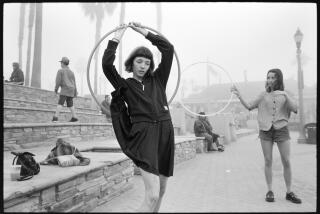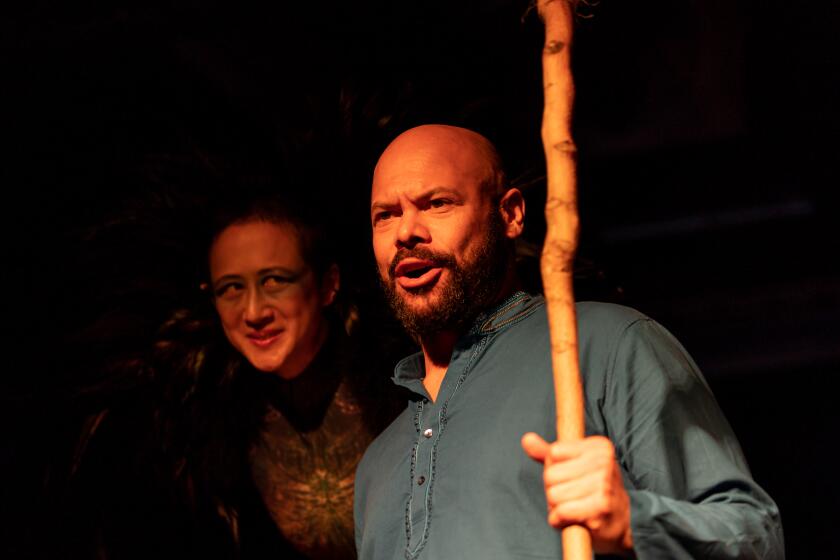For Her, It’s Always About Community
Fourteen white photographs hang on the white walls of the white gallery. Closer inspection reveals a faint, gray horizon line and tiny clusters of brightly colored Monopoly-style houses. These pictures of ice-fishing houses in Minnesota are unlike anything previously photographed by Catherine Opie, an artist who rose to prominence with her regal portraits of gays and lesbians.
“Icehouses” is on view through June 15 at Regen Projects in West Hollywood. The photographs were taken last year when Opie was artist in residence at Minneapolis’ Walker Art Center (a larger exhibition, “Skyways & Icehouses,” is on view there through July 21--skyways are the enclosed glass corridors linking buildings and protecting pedestrians from the elements in Minneapolis). Opie is sitting in her sunny new home in West Adams and remembering chilly Minnesota. “It interested me that the skyways are to Minneapolis as the freeways are to L.A.,” she says, and adds, “The icehouses were visually amazing.”
Photographed in blizzard conditions, each 30-by-40-inch ice-fishing photograph is a field of blinding white. Opie, who is considered a masterful technician, usually prints her own photographs. She made an exception for the “Icehouse” series. To retain a consistent white tone, she resorted to digital printing, knowing that the computer could maintain the same exposures for each photograph. She takes solace in the fact that she had already accomplished a significant technical feat just by making photographs with an 8-by-10-inch view camera, each picture requiring 25 minutes of standing on a frozen lake without freezing the film.
The result surprised even her.
“My work is usually seductive visually and formally,” she says. “But these are pretty in a way that most of my work isn’t. They are just crazy pretty.”
It seems more than coincidence that Opie created such luminous photographs in the year that many of her long-held desires began to be fulfilled. Besides the Walker residency, in the last year, she accepted a tenured position teaching photography at UCLA, bought a house, fell in love with painter Julie Burleigh, and got pregnant with the help of a male friend, Rodney Hill, who was director of her New York gallery, Gorney Bravin + Lee (he has relocated to L.A., to be a partner at the Marc Foxx Gallery).
“In some ways, my dreams have come true,” she reflects.
Opie, 41, has been relating to the world through a lens since she was given an Instamatic for her ninth birthday in Sandusky, Ohio, and photographed every house and intersection in her neighborhood. Being creative ran in the family. Her father operated her grandfather’s craft business, so there was an abundant supply of paper, crayons and paints. Her mother, a physical education teacher, did decoupage.
Her family moved to Rancho Bernardo in north San Diego County in 1974, and a few years later, her parents divorced. Her father did well in real estate and hoped she would take over his business. Yet he supported her decision to enroll at San Francisco Art Institute, where she graduated with a bachelor of fine arts in 1985.
“They pushed you so hard to really learn how to make photographs visually,” she recalls. Great technical training came from photographer Pirkle Jones, who had printed Ansel Adams’ pictures.
“They really taught me how to work too,” she says.
“I shot everything I saw or thought, and it did a lot for me,” she says. “I got to know my camera completely. I just thought about my eye and my hand.”
While completing her master’s degree at CalArts between 1986 and 1988, she documented the master-planned community of Valencia. She started out hating suburban growth, but finally came to see that the banal architecture of the suburb yielded an aesthetic of its own.
Opie says that the connection between those early pieces and her mature work is a fascination with community. In his catalog essay for the Walker exhibition, Douglas Fogel writes that her “entire artistic career can be seen as one long road trip across this continent in search not of the American dream but rather a dream of an idea of American community.”
In fact, the work that first attracted the attention of critics and curators in 1993 involved luscious studio portraits of lesbian and transgender friends in the leather community.
During the 1980s, as she saw friends dying of AIDS, she had a strong urge to make this community more visible. She also wanted to bring dignity to people who were shunned because of their sexual orientation. Her photographs depicted women with hair growth and muscles that were brought on by hormone injections; she refused to identify the subjects by gender.
The work was a personal as well as an artistic milestone. One self-portrait in the series, chosen for the 1995 Whitney Biennial, showed her with her head hooded in leather and the word “pervert” cut into her chest. At that point, she had to inform her parents about her sexuality.
“I always wanted to fit in and be the good corn-fed girl from the Midwest,” she says. “Shifting my work to include a queer identity component was a big deal for me.”
Not that her “Midwestern” yearnings disappeared. In another self-portrait in the 1993 series, Opie photographed her naked back, again tattooed with a knife. This time, though, the image was of two stick-figure women, a small house and the sun coming out from behind a cloud. After the painful breakup of one relationship, Opie made this childlike doodle and asked an artist friend to cut it into her bare back, so that the lines were drawn in blood.
“By placing it on my body, I showed how hard it still is to be queer and want the idea of family too,” Opie says.
Opie was unprepared for the onslaught of media attention that followed her Whitney debut.
It was, she says, “like, ‘Oh there’s the pervert.’ It’s funny when you make this personal work, and it ends up having this whole life out there.”
She decided her next photographs had to be “radically different, if I was going to balance this stuff out, if I was going to have a long career.”
Inspired by her commute to a job in the photo lab at UC Irvine, she began to shoot freeways, using the soft-focus style of 19th century photographs and making platinum prints. “I needed to do something with concrete sweeping architectural forms,” Opie says. “I’ve had a car since the age of 16, and, to me, the freeways always represented this wonderful freedom.”
She went on to photograph architecturally challenged mansions in Beverly Hills and Bel-Air in 1996 and Los Angeles mini-malls in 1997. “Everything I photograph has the connotation of being messy or of being a bad thing,” she admits. “Why? Mini-malls are so much about the identity of Los Angeles, and the specificity of the identity fascinates me. You can discover what neighborhood you’re driving through by looking at signage, whether it is Korean, Chinese or Spanish. These are the community centers for a neighborhood.”
In 1998, she embarked on what she called the “Queer Great American Road Trip.” For 21/2 months, she drove an RV around the country searching for an alternative to the heterosexual model of a domestic relationship. She photographed couples and groups of women around a dining room table, in a backyard, in a swimming pool, and all of them exude a pleasant ordinariness.
“We need to extend our definitions and often we can’t unless it’s pictured,” she says. She considers the series a victory, especially because Al and Tipper Gore have requested that her work be included in their forthcoming book on the American family.
The following year, a Freund Fellowship from Washington University led her to teach for two months in St. Louis, where she began an ongoing series on American cities.
“I do an enormous amount of research,” she says. “My library is filled with books on community and urban politics. I have more books on urban planning in my library than books on art.”
Then in 2000 and 2001, a teaching job at Yale University allowed her to spend time photographing Wall Street in New York, and the Walker residency added Minneapolis and the ice-fishing houses to her list of communities.
“I love the idea that the icehouses are a temporary community,” Opie says. “They only exist on the ice for about two months, but they receive pizza delivery, even prostitutes.
“I like that it messes with the whole economic thing of the house on the lake,” she adds. “Mostly, only the wealthy can have that. Come winter, even the mechanic at the gas station can pull his house onto the lake and he has a lake-view property.
“My work bizarrely leads me down these paths and trails,” she says. “And I want everyone to go there with me.”
Right now, Opie is pleased to be back in Southern California. She met Burleigh, a professor at Washington University, during her residency there. As Opie puts it, “We were friends and then we were girlfriends.”
The job at UCLA brought her home to L.A., and Burleigh followed. With the house in West Adams--a rambling clapboard that could have been shipped airfreight from the Midwest--and the arrival of Oliver, born in February, the picture of domesticity that Opie once had incised on her back is seemingly fulfilled.
And for the moment, domestic bliss is more on her mind than either of her new exhibitions. As a compulsive worker, she has completed at least one new series every year of the past decade. It’s time to slow down.
“It’s good I had Oliver, huh?” she says with a grin. “Otherwise, there would be way too much of my work out there.”
While she talks, she looks out her wide-open front door, Oliver clamped to her breast and the family dog, Nika, sprawled on the floor next to her.
“I was so solid in my dream of a house, a woman who wanted to be married to me, a child,” Opie says, looking back to the days of the stick-figure incision. “I’ve been trying to find that for a very long time. I’m so excited to have found someone who wants this as much as I do.”
*
“CATHERINE OPIE: THE ‘ICEHOUSES,’” Regen Projects, 629 N. Almont Drive, West Hollywood. Dates: Through June 15.Admission: Free. Phone: (310) 276-5424.
*
Hunter Drohojowska-Philp is a frequent contributor to Calendar..
More to Read
The biggest entertainment stories
Get our big stories about Hollywood, film, television, music, arts, culture and more right in your inbox as soon as they publish.
You may occasionally receive promotional content from the Los Angeles Times.










